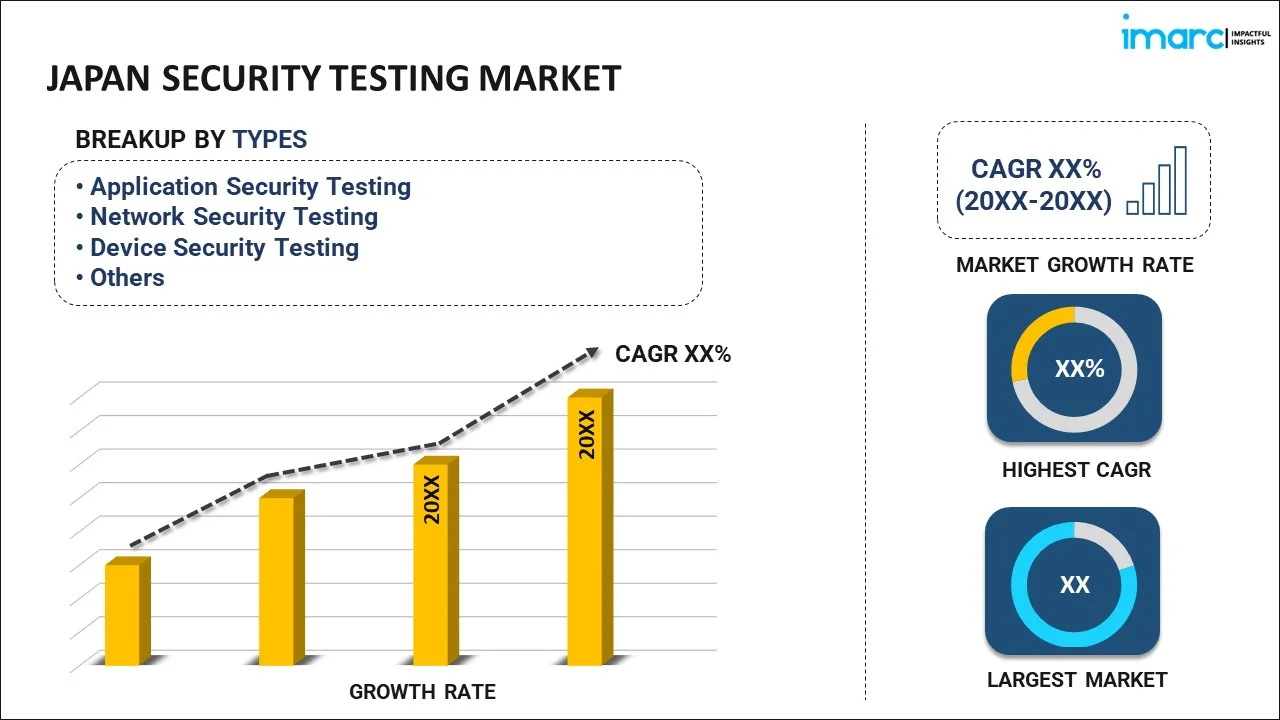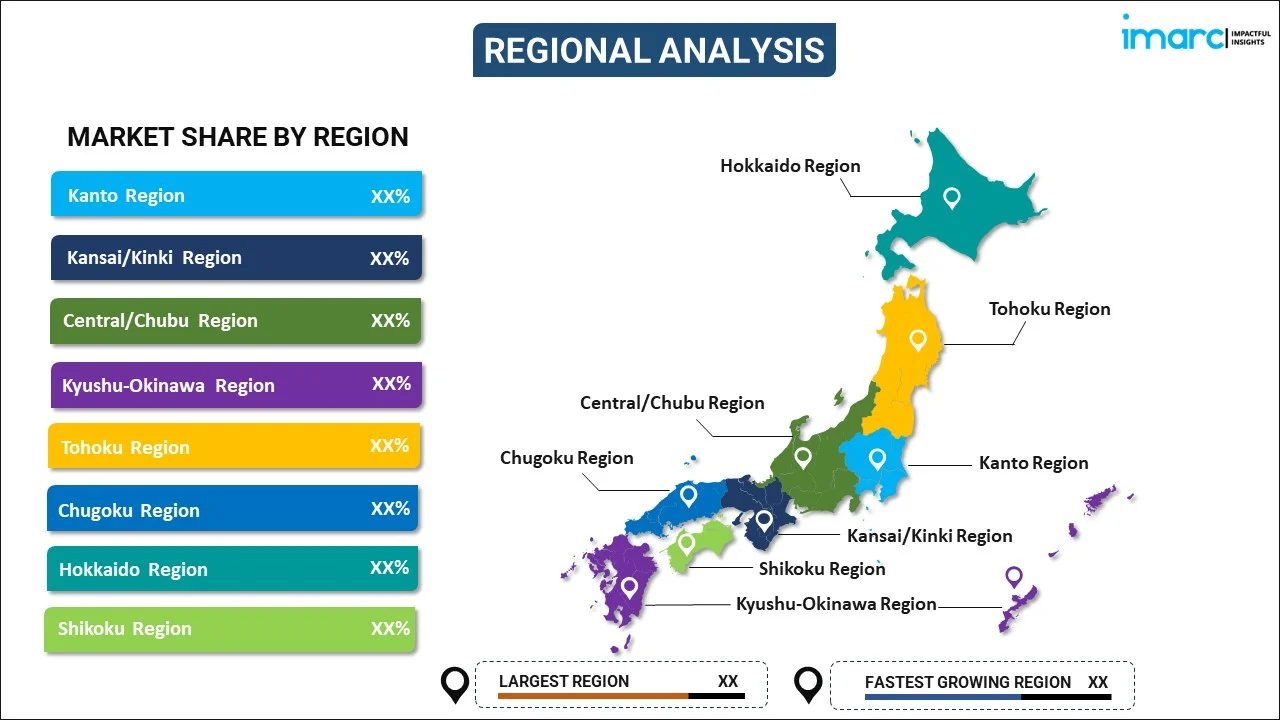
Japan Security Testing Market Report by Type (Application Security Testing, Network Security Testing, Device Security Testing, Social Engineering, and Others), Testing Tool (Web Application Testing Tool, Code Review Tool, Penetration Testing Tool, Software Testing Tool, and Others), Deployment Mode (On-premises, Cloud-based), End User (BFSI, Healthcare, IT and Telecom, Retail and E-Commerce, Education, and Others), and Region 2025-2033
Market Overview:
Japan security testing market size is projected to exhibit a growth rate (CAGR) of 20.7% during 2025-2033. The growing number of small, medium, and large-scale industries that are embracing security testing solutions to fortify their security infrastructure and ensure the integrity and safety of their operations is primarily driving the market growth.
|
Report Attribute
|
Key Statistics
|
|---|---|
|
Base Year
|
2024 |
|
Forecast Years
|
2025-2033 |
|
Historical Years
|
2019-2024
|
| Market Growth Rate (2025-2033) | 20.7% |
Security testing is a crucial process aimed at uncovering vulnerabilities and weaknesses within security mechanisms, ensuring the protection of data and the uninterrupted functioning of an information system. This comprehensive practice encompasses various aspects, including network security, system software security, server-side application security, and client-side application security, offering invaluable assistance to developers in mitigating security threats effectively. The primary objectives of security testing encompass upholding the integrity, confidentiality, authentication, authorization, and non-repudiation of data and resources. By doing so, it acts as a safeguard against a spectrum of threats, risks, malicious attacks, and vulnerabilities that could compromise the security of data, applications, software, and resources. In addition to fortifying security measures, security testing plays a pivotal role in early detection of potential security risks, averting information loss, and protecting an organization's reputation from damage.
Japan Security Testing Market Trends:
In the context of the Japan market, the rapid digital transformation and the emerging trend of automation across various industry sectors have given rise to a growing number of cybercrime incidents. This has significantly heightened the demand for security testing to proactively prevent security breaches and the unauthorized access of sensitive information. Furthermore, the increasing adoption of remote work models, which sustain business operations while adhering to social distancing norms, has introduced complex network connections with varying security protocols. Consequently, this has amplified security concerns and the necessity for robust security testing measures. Additionally, the widespread integration of Internet of Things (IoT) devices and the Bring Your Own Device (BYOD) approach are contributing to the market's expansion. Given the ubiquity of IoT-connected devices in our daily lives, it is imperative to subject these devices to rigorous testing to establish a minimum security baseline. Furthermore, stringent government regulations are driving the heightened adoption of security testing solutions and services, further fortifying market growth. Moreover, the thriving e-commerce sector is prompting organizations to integrate security testing solutions that can effectively monitor vulnerabilities and reduce the overall threat landscape, bolstering the market's growth trajectory.
Japan Security Testing Market Segmentation:
IMARC Group provides an analysis of the key trends in each segment of the market, along with forecasts at the country level for 2025-2033. Our report has categorized the market based on type, testing tool, deployment mode, and end user.
Type Insights:

- Application Security Testing
- Network Security Testing
- Device Security Testing
- Social Engineering
- Others
The report has provided a detailed breakup and analysis of the market based on the type. This includes application security testing, network security testing, device security testing, social engineering, and others.
Testing Tool Insights:
- Web Application Testing Tool
- Code Review Tool
- Penetration Testing Tool
- Software Testing Tool
- Others
A detailed breakup and analysis of the market based on the testing tool have also been provided in the report. This includes web application testing tool, code review tool, penetration testing tool, software testing tool, and others.
Deployment Mode Insights:
- On-premises
- Cloud-based
The report has provided a detailed breakup and analysis of the market based on the deployment mode. This includes on-premises and cloud-based.
End User Insights:
- BFSI
- Healthcare
- IT and Telecom
- Retail and E-Commerce
- Education
- Others
A detailed breakup and analysis of the market based on the end user have also been provided in the report. This includes BFSI, healthcare, IT and telecom, retail and e-commerce, education, and others.
Regional Insights:

- Kanto Region
- Kansai/Kinki Region
- Central/ Chubu Region
- Kyushu-Okinawa Region
- Tohoku Region
- Chugoku Region
- Hokkaido Region
- Shikoku Region
The report has also provided a comprehensive analysis of all the major regional markets, which include Kanto Region, Kansai/Kinki Region, Central/ Chubu Region, Kyushu-Okinawa Region, Tohoku Region, Chugoku Region, Hokkaido Region, and Shikoku Region.
Competitive Landscape:
The market research report has also provided a comprehensive analysis of the competitive landscape. Competitive analysis such as market structure, key player positioning, top winning strategies, competitive dashboard, and company evaluation quadrant has been covered in the report. Also, detailed profiles of all major companies have been provided.
Japan Security Testing Market Report Coverage:
| Report Features | Details |
|---|---|
| Base Year of the Analysis | 2024 |
| Historical Period | 2019-2024 |
| Forecast Period | 2025-2033 |
| Units | Million USD |
| Scope of the Report | Exploration of Historical Trends and Market Outlook, Industry Catalysts and Challenges, Segment-Wise Historical and Future Market Assessment:
|
| Types Covered | Application Security Testing, Network Security Testing, Device Security Testing, Social Engineering, Others |
| Testing Tools Covered | Web Application Testing Tool, Code Review Tool, Penetration Testing Tool, Software Testing Tool, Others |
| Deployment Modes Covered | On-premises, Cloud-based |
| End Users Covered | BFSI, Healthcare, IT and Telecom, Retail and E-Commerce, Education, Others |
| Regions Covered | Kanto Region, Kansai/Kinki Region, Central/ Chubu Region, Kyushu-Okinawa Region, Tohoku Region, Chugoku Region, Hokkaido Region, Shikoku Region |
| Customization Scope | 10% Free Customization |
| Post-Sale Analyst Support | 10-12 Weeks |
| Delivery Format | PDF and Excel through Email (We can also provide the editable version of the report in PPT/Word format on special request) |
Key Questions Answered in This Report:
- How has the Japan security testing market performed so far and how will it perform in the coming years?
- What has been the impact of COVID-19 on the Japan security testing market?
- What is the breakup of the Japan security testing market on the basis of type?
- What is the breakup of the Japan security testing market on the basis of testing tool?
- What is the breakup of the Japan security testing market on the basis of deployment mode?
- What is the breakup of the Japan security testing market on the basis of end user?
- What are the various stages in the value chain of the Japan security testing market?
- What are the key driving factors and challenges in the Japan security testing?
- What is the structure of the Japan security testing market and who are the key players?
- What is the degree of competition in the Japan security testing market?
Key Benefits for Stakeholders:
- IMARC’s industry report offers a comprehensive quantitative analysis of various market segments, historical and current market trends, market forecasts, and dynamics of the Japan security testing market from 2019-2033.
- The research report provides the latest information on the market drivers, challenges, and opportunities in the Japan security testing market.
- Porter's five forces analysis assist stakeholders in assessing the impact of new entrants, competitive rivalry, supplier power, buyer power, and the threat of substitution. It helps stakeholders to analyze the level of competition within the Japan security testing industry and its attractiveness.
- Competitive landscape allows stakeholders to understand their competitive environment and provides an insight into the current positions of key players in the market.
Need more help?
- Speak to our experienced analysts for insights on the current market scenarios.
- Include additional segments and countries to customize the report as per your requirement.
- Gain an unparalleled competitive advantage in your domain by understanding how to utilize the report and positively impacting your operations and revenue.
- For further assistance, please connect with our analysts.
 Inquire Before Buying
Inquire Before Buying
 Speak to an Analyst
Speak to an Analyst
 Request Brochure
Request Brochure
 Request Customization
Request Customization




.webp)




.webp)












